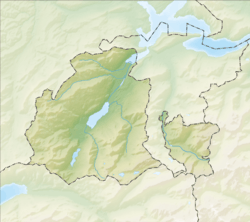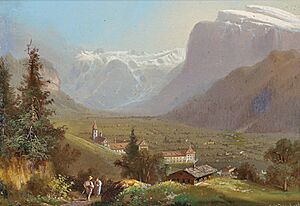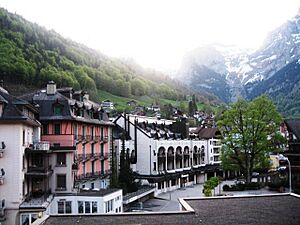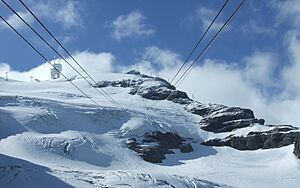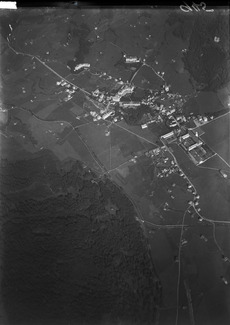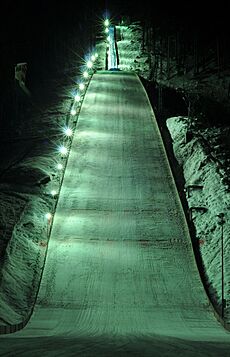Engelberg facts for kids
Quick facts for kids
Engelberg
|
||
|---|---|---|
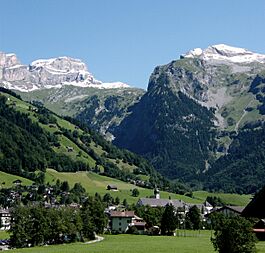
View from Engelberg towards northeast with the snow covered Lauchernstock and the Ruchstock to the left, and the Gross Gemsispil to the right (mid-August 2007)
|
||
|
||
| Country | Switzerland | |
| Canton | Obwalden | |
| District | n.a. | |
| Area | ||
| • Total | 74.87 km2 (28.91 sq mi) | |
| Elevation
(The monastery's church)
|
1,013 m (3,323 ft) | |
| Highest elevation
(Mount Titlis)
|
3,238 m (10,623 ft) | |
| Lowest elevation
(Engelberger Aa in Grafenort)
|
556 m (1,824 ft) | |
| Population
(Dec 2020 )
|
||
| • Total | 4,194 | |
| • Density | 56.017/km2 (145.084/sq mi) | |
| Demonym(s) | German: Engelberger(in) | |
| Postal code |
6390 Engelberg, 6388 Grafenort
|
|
| Localities | Grafenort, Oberberg, Neuschwändi, Niederberg, Mühlebrunnen, Schwand, Obermatt, Gerschni, Horbis, Brunni, Herrenrüti, Fürenalp, Griessental | |
| Surrounded by | Attinghausen (UR), Gadmen (BE), Innertkirchen (BE), Isenthal (UR), Wassen (UR), Wolfenschiessen (NW) | |
Engelberg means "mountain of angels." It is a village and a municipality in the canton of Obwalden in Switzerland. Besides the main village, Engelberg also includes smaller areas like Grafenort, Oberberg, and Schwand.
Engelberg is special because it's an exclave. This means it's a part of Obwalden canton, but it's completely surrounded by other cantons: Bern, Nidwalden, and Uri.
This village is a popular mountain resort in Central Switzerland. Long ago, in the Middle Ages, it was famous for its Benedictine monastery, called Engelberg Abbey. Over time, especially from the 1800s onwards, Engelberg became a well-known place for vacations. The closest big city is Lucerne.
Even though the official language in Engelberg is Swiss German, most people speak a local version of the Alemannic Swiss German dialect.
Contents
History of Engelberg
Early Beginnings
Engelberg was first mentioned in records in the year 1122. This was around the same time the famous Engelberg Abbey was founded. Before that, local people already used the mountain pastures of Trüebsee together.
In August 1815, the canton of Nidwalden was slow to accept a new agreement for Switzerland called the Federal Treaty. Engelberg quickly showed its support for the treaty. Federal troops then entered Nidwalden, which led to them finally accepting the treaty on August 18, 1815. Because of this, Engelberg became part of the canton of Obwalden.
Becoming a Tourist Spot
In the mid-1800s, Engelberg started to become a vacation spot. People came for its special mineral water, milk treatments, and fresh air. Families like Cattani, Hess, and Odermatt helped build many hotels. This made the area a popular place for tourists. To make it easier for visitors, a wider road was built between 1872 and 1874. Also, an electric railway from Stansstad to Engelberg opened in 1898.
By the late 1800s, Engelberg became known for hiking and other mountain activities. The winter sports season began in 1903-1904. A funicular railway, the Gerschnialpbahn, opened in 1913. It connected Engelberg to Gerschni. Later, in 1927, a cable car extended the journey to Ober Trüebsee. Before World War I, many visitors came to Engelberg. In 1911, there were over 165,000 overnight stays.
More roads were built, and the railway line was extended to Lucerne in 1964. This made Engelberg even easier to reach. In 1967, the higher part of the Titlis cable car opened. Over the years, Engelberg also started hosting conferences. By the year 2000, tourism and other services provided most of the jobs in Engelberg.
Geography of Engelberg
Engelberg is located in the Uri Alps mountain range. It is surrounded by several tall mountains. To the south is Titlis, which is 3,238 meters (10,623 feet) high. To the north are the Walenstöcke (2,572 m or 8,438 ft) and Ruchstock (2,813 m or 9,229 ft). To the east, you'll find Hahnen (2,606 m or 8,550 ft) and Wissberg (2,627 m or 8,619 ft).
The average height of Engelberg is about 1,020 meters (3,346 feet) above sea level. The village is in a valley surrounded by very steep mountains. The highest point within the municipality is Titlis. The Engelberg Valley is drained by the Engelberger Aa river. This river flows into Lake Lucerne.
Getting Around Engelberg
Train and Bus Services
Engelberg has two train stations on the Luzern–Stans–Engelberg line. The main station, Engelberg railway station, is in the village. It's the end of the line. Grafenort station is one stop north. Both stations have hourly trains that connect to the city of Lucerne.
A free bus system helps people get around the village during the day. In winter (December to April), there are seven bus routes. In summer (April to October), there is one main route.
Older Transport Systems
The Drahtseilbahn Engelberg–Hotel Terrasse was a funicular railway that ran from the village to Hotel Terrace. It operated from 1905 to 2008. The Gerschnialpbahn funicular opened in 1913.
Things to Do in Engelberg
Engelberg offers many activities for tourists. In winter, people enjoy skiing and other snow sports. In summer, hiking and mountain activities are popular.
Main Sights in the Village
In the village, you can visit the Benedictine monastery, Engelberg Abbey. It has a cheese factory and a shop where you can see how cheese is made. The Talmuseum shows the history of the area and Swiss country life. There are also several old chapels to see.
Winter Sports
The winter sports season usually runs from December to April. However, on the high glacier areas of the Titlis, advanced skiers can sometimes ski from October to May. There is usually plenty of snow. Artificial snow machines have been added to some lower slopes to ensure good snow cover.
Engelberg hosts a major ski jumping World Cup event at the Gross-Titlis-Schanze jump.
Festivals and Events
Like the rest of Switzerland, Engelberg celebrates Swiss National Day on August 1st. There are parades and events all day long.
On the last Saturday in September, the Alpabzug takes place. This is when the cattle are brought down from the mountain pastures. They return to their barns in the village and valley for the winter.
Mountain Areas for Activities
There are three main mountain areas near the village. They offer different activities in both winter and summer. The cable cars usually run all year, giving access to hikers, mountain bikers, and skiers.
Titlis Mountain Area
The Titlis mountain is south of Engelberg. It stands at 3,238 meters (10,623 feet) above sea level. It is the highest peak in this part of the Alps.
You can reach the Titlis mountain using the Titlis Bergbahnen cable cars. The main cable car station is also where the village buses stop. A funicular railway, built in 1913, goes up to Gerschnialp station (1,267 m or 4,157 ft). This area has wide Alpine pastures with easy snow for beginners and cross-country ski trails. There's also a toboggan run that goes back down to the valley station. In summer, you can find two cheese dairies here. There are walking trails leading up to Ober Trüebsee or back down to the village.
The "Titlis Xpress" gondola lift opened in 2015. It goes from the valley station (996 m or 3,268 ft) up to the middle station Trübsee (1,788 m or 5,866 ft), and then to Stand (2,428 m or 7,966 ft). This area has more challenging skiing. You can also take chair lifts to the Jochpass (2,207 m or 7,241 ft) and below the Jochstock (2,508 m or 8,228 ft). A continuous ski run goes down to Unter Trüebsee and back to the cable car station. In summer, the lake at Trübsee is great for walkers. You can rent rowing boats and find picnic spots. Walking routes lead over the Jochpass to Engstlenalp and Melchsee-Frutt.
The "Rotair" cable car is special because it's the world's first rotating cable car. It goes up to the Kleintitlis mountain station (3,028 m or 9,934 ft). Here, you'll find a restaurant, shops, and an observation deck. You can also access the glacier and the summit from here. The high-altitude glacier runs are for advanced skiers. There are also off-piste routes down to Trüebsee and the Laubersgrat ridge.
Brunni Mountain Area
The Brunni mountain area is north of the village. You can reach it from a cable car station that goes up to Ristis (1,600 m or 5,249 ft). From there, another chair lift goes up to Brunnihütte (1,860 m or 6,102 ft). The ski runs here are for beginners to medium-level skiers. Sometimes, they have less snow than the Titlis side because they face south. There is also a toboggan run from Brunnihütte back down to Ristis. In summer, many walking trails start here. These include the Walenpfad leading to Bannalp and the Rot Grätli ridge across the mountains. There are also prepared rock climbing routes called Klettersteig.
Fürenalp Mountain Area
At the eastern end of the Engelberg valley, there is a cable car up to Fürenalp (1,840 m or 6,037 ft). It passes over the Fürenwand rock climbing area. From the top station or the valley, you can find summer walking routes. These offer views of the Chli Spannort (3,140 m or 10,302 ft) and Gross Spannort (3,198 m or 10,492 ft) mountain peaks. The trails lead to the Surenenpass (2,291 m or 7,516 ft) in the east.
Important Heritage Sites
Engelberg has three sites that are very important to Swiss history and culture. These are the Engelberg Abbey with its library, archives, and music collection. Also, the mansion (Herrenhaus) in Grafenort and the Holy Cross chapel in Grafenort are important.
-
The Benedictine Abbey
Population of Engelberg
The number of people living in Engelberg has changed over time:
| Year | Population |
|---|---|
| 1709 | 678 |
| 1799 | 1,468 |
| 1850 | 1,737 |
| 1900 | 1,973 |
| 1950 | 2,544 |
| 2000 | 3,544 |
| 2010 | 3,859 |
Religion in Engelberg – 2010 Roman Catholic (66%) Swiss Reformed Church (13%) Other Christian/religion (12%) Undeclared/unaffiliated (9%)
As of 2016, Engelberg has a population of about 4,100 people. About 26% of the people living there are foreign nationals. Most people in Engelberg speak German as their first language (88.2%). Serbo-Croatian is the second most common language (2.5%), and English is third (2.2%).
Education in Engelberg
In Engelberg, many adults (between 25 and 64 years old) have completed higher education. This means they have gone to a university or a specialized college. About 65.5% of the population in this age group has achieved this level of education.
Economy and Business
Engelberg is known as a tourist community. In 2014, over 2,500 people worked in the municipality. Most jobs (over 2,100) were in the service industry, especially tourism.
In 2015, hotels in Engelberg had over 350,000 overnight stays. Most of these visitors (67.1%) came from other countries.
Because it has snowy mountains, Engelberg has been used as a filming location for some Indian films. These films needed a snowy mountain setting like Kashmir, but filming there can be difficult.
Climate in Engelberg
Engelberg has a long winter season. It gets a lot of snow, and the air is not very humid. Between 1991 and 2020, Engelberg had about 151 days of rain or snow each year. On average, it received 1,568 millimeters (61.7 inches) of precipitation. July was the wettest month, with 198 mm (7.8 in) of precipitation over 15.7 days. February was the driest month, with 81 mm (3.2 in) of precipitation over 10 days.
| Climate data for Engelberg (reference period 1991–2020) at 1,036 metres (3,399 ft) | |||||||||||||
|---|---|---|---|---|---|---|---|---|---|---|---|---|---|
| Month | Jan | Feb | Mar | Apr | May | Jun | Jul | Aug | Sep | Oct | Nov | Dec | Year |
| Mean daily maximum °C (°F) | 2.0 (35.6) |
3.0 (37.4) |
7.3 (45.1) |
11.7 (53.1) |
16.0 (60.8) |
19.3 (66.7) |
21.0 (69.8) |
20.6 (69.1) |
16.3 (61.3) |
12.2 (54.0) |
6.4 (43.5) |
2.8 (37.0) |
11.6 (52.9) |
| Daily mean °C (°F) | −1.7 (28.9) |
−1.1 (30.0) |
2.5 (36.5) |
6.3 (43.3) |
10.4 (50.7) |
13.8 (56.8) |
15.4 (59.7) |
15.2 (59.4) |
11.4 (52.5) |
7.6 (45.7) |
2.5 (36.5) |
−0.8 (30.6) |
6.8 (44.2) |
| Mean daily minimum °C (°F) | −5.3 (22.5) |
−5.1 (22.8) |
−1.7 (28.9) |
1.5 (34.7) |
5.4 (41.7) |
8.9 (48.0) |
10.7 (51.3) |
10.7 (51.3) |
7.2 (45.0) |
3.8 (38.8) |
−0.9 (30.4) |
−4.2 (24.4) |
2.6 (36.7) |
| Average precipitation mm (inches) | 89 (3.5) |
91 (3.6) |
98 (3.9) |
112 (4.4) |
166 (6.5) |
179 (7.0) |
198 (7.8) |
196 (7.7) |
128 (5.0) |
110 (4.3) |
102 (4.0) |
107 (4.2) |
1,568 (61.7) |
| Average snowfall cm (inches) | 78.5 (30.9) |
82.1 (32.3) |
75.4 (29.7) |
43.2 (17.0) |
3.6 (1.4) |
0.0 (0.0) |
0.0 (0.0) |
0.0 (0.0) |
0.0 (0.0) |
7.1 (2.8) |
52.5 (20.7) |
72.4 (28.5) |
414.8 (163.3) |
| Average precipitation days | 11.4 | 10.0 | 12.2 | 12.0 | 14.5 | 15.9 | 15.7 | 14.7 | 11.7 | 10.3 | 10.9 | 11.7 | 151.0 |
| Average snowy days | 8.4 | 8.1 | 7.8 | 5.4 | 0.8 | 0.0 | 0.0 | 0.0 | 0.0 | 0.7 | 5.2 | 8.3 | 44.7 |
| Average relative humidity (%) | 79 | 77 | 74 | 72 | 76 | 78 | 79 | 81 | 84 | 82 | 81 | 80 | 79 |
| Mean monthly sunshine hours | 51 | 92 | 128 | 146 | 147 | 158 | 164 | 157 | 131 | 112 | 62 | 31 | 1,380 |
| Source: MeteoSwiss (snow 1981–2010) | |||||||||||||
Famous People from Engelberg
- Baroness Felicitas von Reznicek (1904-1997), a German writer and British agent during World War II.
- Herbert Matter (1907–1984), an American photographer and graphic designer.
- Giuseppe Piazzi (1907–1963), a bishop from Bergamo.
- Hermann Hess Helfenstein (1916-2008), a Swiss naturalist, explorer, climber, and engineer.
Sports Stars
- Rolf Olinger (1924–2006), a Swiss alpine skier who won a bronze medal at the 1948 Winter Olympics.
- Erika Hess (born 1962), an alpine skier who won a bronze medal at the Alpine skiing at the 1980 Winter Olympics.
- Dominique Gisin (born 1985), an alpine skier who won a gold medal at the 2014 Winter Olympics.
- Denise Feierabend (born 1989), a former Swiss World Cup alpine ski racer.
- Michelle Gisin (born 1993), an alpine ski racer who won gold medals at the 2018 and 2022 Winter Olympics.
- Lena Häcki (born 1995), a junior Biathlon silver medallist.
- Fabian Bösch (born 1997), an Olympic freestyle skier and 2015 slopestyle gold medallist.
- Fabio Scherer (born 1999), a racing driver.
See also
 In Spanish: Engelberg para niños
In Spanish: Engelberg para niños




